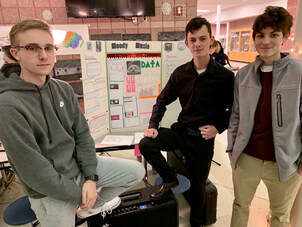 Photo by Paul Menke
Photo by Paul Menke By Paul Menke
Tuesday night, Mashpee Middle High School kicked off its first ever Science and Engineering Fair, with entries varying to the effects of vaping to the effects of UV light on bread mold growth. The event was organized by Mrs. Soares, a science teacher here at Mashpee, and Mr. Hoppensteadt, the school’s Science Department Head.
Mr. Hoppensteadt had a few thoughts on the school’s new academic accomplishment: “The fair went along smoothly … was exciting, and I am very grateful for all of our entries and volunteers who helped make it a success. All of the entries were great and interesting in their own way.”
Tuesday night, Mashpee Middle High School kicked off its first ever Science and Engineering Fair, with entries varying to the effects of vaping to the effects of UV light on bread mold growth. The event was organized by Mrs. Soares, a science teacher here at Mashpee, and Mr. Hoppensteadt, the school’s Science Department Head.
Mr. Hoppensteadt had a few thoughts on the school’s new academic accomplishment: “The fair went along smoothly … was exciting, and I am very grateful for all of our entries and volunteers who helped make it a success. All of the entries were great and interesting in their own way.”
The fair received thirty-two entries, more than expected, varying from projects made by a single student to projects made by small groups of four students. Twenty-three scientifically experienced adults volunteered to judge the project.
The first place project was “How Songs Affect Mood” by Nathan Howard, Addison Weiner, and Ross Smith, which detailed how certain songs of varying genres affect the moods of the listeners.
“What Type of Learner Are You?” by Diana Geoffrion, Eduarda Zanoni, and Abigail Aia took second place, which focuses on the different learning styles.
Thirdly, “Age vs. Hoverboards” by Megan Binette, Brooke Johnston and Bridget O’Neill won third place, and highlighted how quickly older generations learned to hoverboard compared to younger generations. The third place and runner-up entries won $100 prizes to be split evenly among the group, while the winning group won $100 prizes for each group member.
Other entries included a few experiments on local water quality, which concluded that John’s Pond has good water quality, and other lakes like Peter’s Pond and Santuit Pond had mediocre water quality.
There was also an experiment on how corrosive commonly consumed sodas were. These sodas included Coca-Cola, Pepsi, Sprite, Dr. Pepper, A&W Root Beer, Orange Fanta, and Mountain Dew. The conclusion was that Pepsi was the most corrosive, and A&W Root Beer was the least corrosive of the bunch.
And an experiment was made on the bacteria-killing effectiveness of various methods of cooking. It resulted in pan-searing as the most effective, followed by frying, and then baking.
As an extra incentive to participate in the science fair, the science department promised each student who entered with an acceptable, appropriate, and interesting experiment with a guaranteed 90 on this year’s Midterm grade for their science course, with additional points added for the success of the testing grade.
What’s next for the Mashpee High School Science Fair? The winner and runner-up will go straight to the Massachusetts Institute of Technology (MIT) for the State Finals. The Science Department hopes to continue this program for years to come, as it encourages students to be inquisitive about the world around them.